Wheat and Wheat Grinding 101: The Wheat {Types, Where to Buy, and What to Make}
I’ve alluded to this post/series for a while now but I’m more excited than should be deemed rational to finally be bringing you the first installment of the official Wheat and Wheat Grinding 101 series. Perhaps I’m the only one that gets giddy when talking about wheat (Huh? Weird? Me?) but alas, I do and I hope some of this information will be beneficial to those of you interested in wheat and wheat grinding.
I make no effort to hide my deep and abiding love for my wheat grinder and all the benefits it affords me and our family; namely assisting in making our own 100% whole wheat bread for the last three years. However, it took me a while to figure out the ins and outs of wheat and wheat grinding in general.
So over the next few weeks, I’ll be posting two or three more installments for Wheat 101 (including different types of wheat grinders and reviews of those, ways to use wheat and other whole grains, and a whole lot of resources).
Today, let’s talk about the main types of wheat to use in whole grain baking and cooking, the differences between them, where you can buy them and how you can use them in baking/cooking. Whether you make your own bread or not, whole wheat berries/flour can be used in many ways.
Disclaimer: I’m hitting on the wheat varieties that are common, easy to find, and that I’ve used for many years with great success. They are my preferred varieties of wheat but I have friends/family who use other types (like kamut, in particular) so feel free to do your own research on some of those wheat outliers.
Okie doke. Ready? First off, in case you didn’t know, wheat that has been hulled but unmilled (like you see below) is called wheat berries. I’ll refer to “berries” often throughout this post and didn’t want you to be looking for pictures of fresh fruit if you are new to wheat terminology.
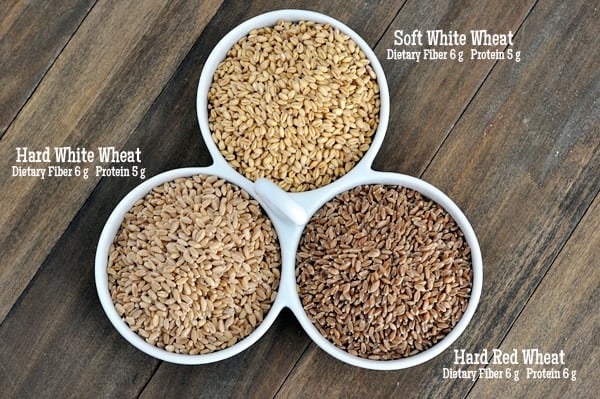
First up, let’s take a closer look at soft white wheat. The berries themselves are rounder in shape and they are lighter and more yellow in color than the other two types of wheat.
Soft white wheat, finely ground, is perfect for tender, light baked goods. Bread, rolls, and even pie crusts, pastries and cookies.
Next, we have hard red wheat. It is noticeably darker than the other two white wheat varieties. Because of it’s slightly higher protein content, it is better used for heartier, heavier breads.
It isn’t going to yield the same light color and texture in a baked good that a variety of white wheat will. Many people who try whole wheat bread with red wheat first are sometimes disappointed because it tends to produce heavy, dark loaves.
I always recommend using hard white wheat to start; for some reason, it seems easier to develop the gluten and get a lighter, more tender bread. I’m not anti-red wheat (you’ll find out more below); but it is the type of wheat that sometimes gives wheat bread in general a bad rep.
Finally, hard white wheat. Light color, just like soft white wheat, but it has a slightly longer, thinner berry shape. This is the type of wheat I use the most.
It is a great all-purpose wheat flour to use as it works great in yeasted breads/rolls and also in cookies and other baked goods.
When ground, the wheat berries produce flour at any level of coarseness or fineness, depending on your grain mill or wheat grinder. My rule of thumb, unless I’m going for a cracked wheat cereal, is to grind as finely as my grain mill allows because I like to be able to sub the wheat flour in for all-purpose flour and the more finely ground it is, the more easily I can substitute one-for-one with all-purpose flour.
I’ll be talking more in-depth about wheat grinders in a week or so, but a good rule of thumb is that one cup of wheat berries produces about 2 cups flour. Keep in mind, though, that freshly ground wheat flour is full of air from shooting out of the grinder so measuring freshly ground wheat can be a bit tricky (and is also the reason I use approximate amounts of flour for whole wheat bread recipes instead of exact measurements). I either let the flour settle for 30 minutes or so, or if I’m going to use it right away, I forget my standard flour measuring rule, and pack it in the cup a bit more to account for the airiness of just being ground.
You can see from the picture below that the ground wheat flour varies slightly in color, too, depending on the variety of wheat.
It’s hard to see it in this picture below, but the hard red wheat flour (far right) has a bit more texture and a darker color than the soft white wheat flour to the right.
I mentioned above that I prefer using hard white wheat flour. It is definitely what I use 90% of the time; however, I have about 100 pounds of hard red wheat hanging out in storage that I bought 10 years ago that I’m trying to use up, so for the last year, I’ve mixed hard red wheat and hard white wheat (grinding it together) when making bread.
And after shooting pictures for this tutorial, I made bread with all three varieties and what do you know? I think it was the best bread I’ve ever made. So, basically, experiment with the type of wheat you prefer – it will vary widely among every person.
When I lived in Northern Minnesota, I bought it from a local, organic mill near my home (I know, can you believe I moved to the middle of nowhere with an organic grain mill within 40 minutes? Awesome). They do provide shipping if you are interested in checking out their site, but I have to imagine shipping costs are pretty steep since wheat isn’t exactly feather light.
I’ve also found hard white wheat berries at:
- my local Walmart (on the very bottom shelves under the flour)
- Winco (a grocery store in my area in Idaho – they carry it in 25 pound bags)
- a local farm in Ontario, Oregon (Corn Family Farms – check around for any local farms in your area)
There are many, many online sources for wheat, but be aware that shipping costs can run high, so it might be best to check your local resources first. Here are a few online resources (I am not affiliated with any of these but have bought various products from all of them in the past with great results):
Pleasant Hill Grain (probably one of the more reasonable places to buy online)
Emergency Essentials (again, as I looked at their sales/prices, pleasantly surprised)
Shelf Reliance (more expensive but has convenient scheduled shipments, if that floats your boat, and their wheat is non-GMO)
Another resource is the LDS (Mormon) Home Storage Centers. I’m pretty sure you do not need to be a member of the LDS church to can dry goods at the Home Storage Centers (and based on several comments; that’s correct!). Here is a list of Home Storage Center locations; call for details. Their prices are extremely low, in part because you have to/get to pack it and seal it yourself either in cans or mylar bags.
Alternately, if you don’t live near a Home Storage Center, you can order #10 cans of wheat online at store.lds.org. It runs about $33 for 30 pounds of wheat (they only offer hard white or hard red wheat) and shipping is free, although you do have to live in the continental United States to order online (thanks for your comments clarifying that!).
Feel free to share any other resources you’ve found for buying wheat in the comments!
A quick note on storing wheat berries: as with most dry goods, they should be stored in a dry, cool place. My sealed cans and buckets are kept in our basement storage (wheat, if stored properly, can be kept for up to 20 years or longer!) but I keep a large 50 pound bucket in my kitchen that I fill up with the #10 cans or bags of wheat that I buy or bring up from my personal storage.
This bucket is not sealed, meaning, it won’t keep out bugs or little hands that like to let the wheat run through their chubby fingers, but I use this wheat up quickly and regularly, so as long as I keep the lid closed, I’ve never had problems with bugs (although those pesky little hands still find their way in!).
The lid is a nifty two-piece plastic ring with a lid that screws on and off. It is brilliant and saves me from prying off the original lid that came with the bucket.
These two-piece lids (sometimes called Gamma Seal Lids), meant to be used with food-grade 50# buckets, can be found online at any of the wheat resource links above (here is a link from Pleasant Hill Grain).
Now on to the good stuff.
The obvious answer is clearly to use it in breads and rolls (but scroll down for some ideas that are a bit outside of the bread box). I have dozens of yeast recipes on my site and while I haven’t specified in each and every one, it’s a given that any time I make rolls or bread, I use whole wheat flour in place of all-purpose flour.
For bread, I always use my trusted 100% whole wheat recipes. For rolls and other breads, I generally use at least half whole wheat flour, sometimes more and sometimes less (with the exception of this ciabatta bread, this rustic crusty bread and a small handful of others which I always splurge and make 100% white flour).
However, you can think outside of the box and use wheat berries in many other ways besides bread. Here are some good ones:
- Homemade Cream of Wheat Cereal: Toast the wheat berries in the oven until lightly golden, let them cool, then grind them in a grain mill or wheat grinder to the texture of hot cereal, not fine like flour but not as coarse as cracked wheat. You could probably even do that in a blender. Cook or microwave 1 cup of the toasted ground wheat berries in 3 cups water for a delicious, hot cream of wheat breakfast (this is honestly one of my boys’ favorite breakfast choices with blueberries and a touch of brown sugar and milk).
- Pancake Mix: I use 100% whole wheat flour for our favorite oatmeal pancake mix. It’s hearty, healthy and totally delish.
- Traditional Cracked Wheat: If your wheat grinder can hack it, grind the wheat berries for cracked wheat cereal.
- Whole Wheat Blender Pancakes/Waffles: This unique recipe doesn’t use flour at all; it starts with whole wheat berries that are blended with buttermilk and other ingredients. It’s another breakfast staple at our house. You can use any type of wheat berry for these.
- Wheat as a Meat Extender: You can get all wild and crazy and use wheat as a meat extender. It’s amazing! My friend Jenna told me about this years ago after she served me stroganoff that was so tasty, I asked for the recipe and she shyly admitted that the “meat” in the recipe was at least 1/2 wheat berries. WHAT? I couldn’t even tell. It’s been years since I’ve employed this method myself (I need to start again!) but I can vouch that it works. The wheat takes on the taste and texture of the meat plus it adds a whole lot of extra protein and fiber. Basically you use cooked wheat berrries (cracked wheat) and simmer it with your meat (for tacos, stroganoff and other ground beef/turkey meals that simmer or cook for a bit). Google “wheat meat extender” and you’ll get some good ideas.
Well, I think that does it for today! Next up will be a thorough look at wheat grinders. Yahoo! (Seriously, stay in your seats, people.)
Please feel free to leave any questions in the comments and I’ll get to them as soon as I can; alternatively, I’d love any suggestions about the discussion today. I have a feeling I can learn a lot from all of your experiences with wheat, too!


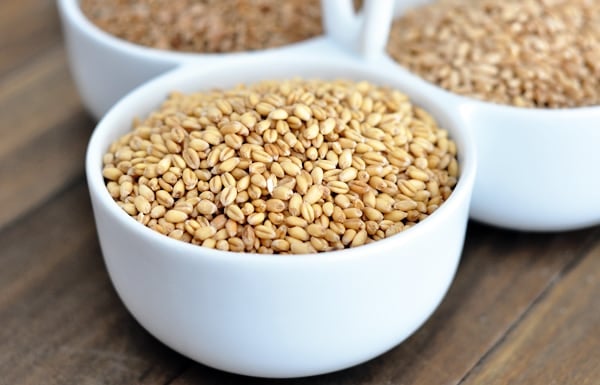
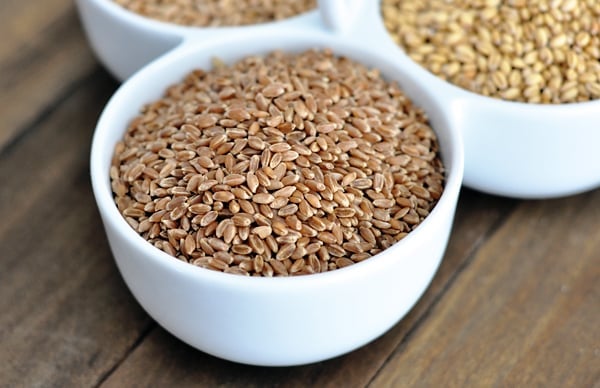
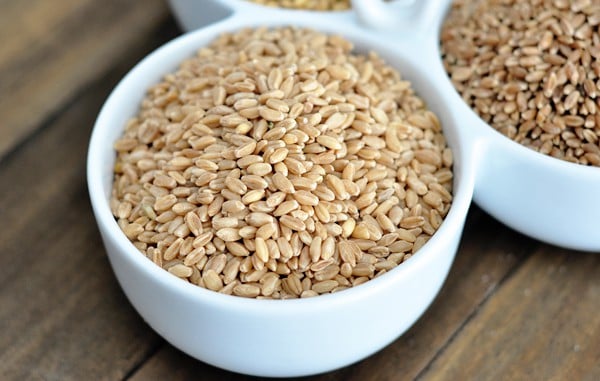
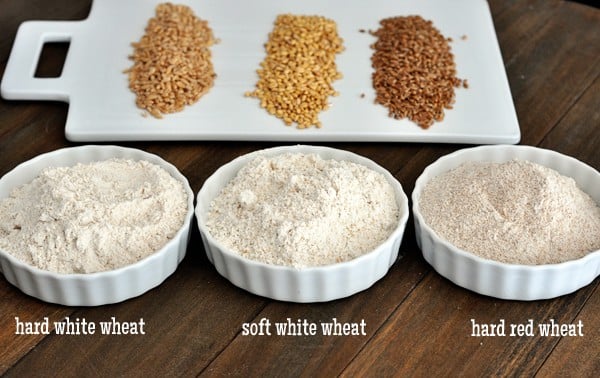
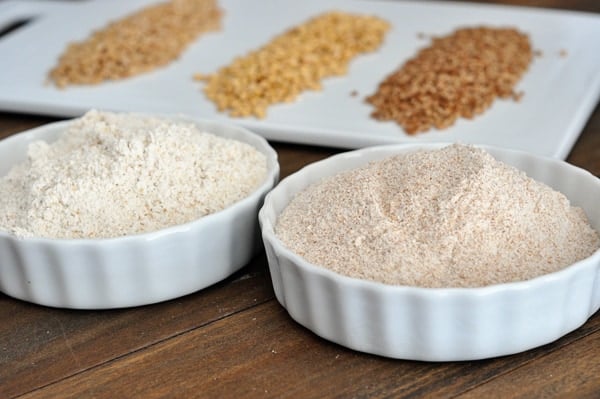

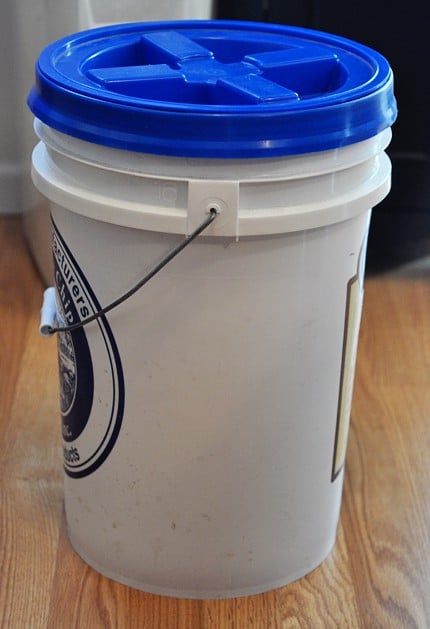
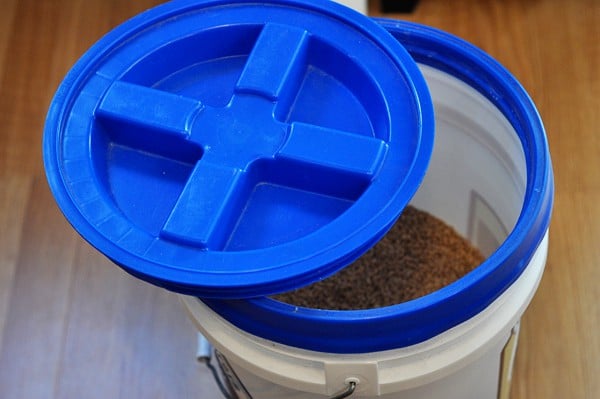
Hi Mel! I love this post and I’m really interested in how to make the homemade cream of wheat and would love more details. How do you roast it, oven or stove top? What kind of pan? What quantity of berries do you roast at a time? Thanks! I love your recipes 🙂
Hi Jamie – I roast them in the oven on a large, rimmed baking sheet. I just watch it carefully and haven’t actually timed it – I’d say 350 degrees for 10-12 minutes, stirring often. You’ll be able to kind of smell it roasting and tell that it is browning. I let it cool completely and then grind it up. I usually do anywhere from 2-4 cups at a time. Sorry for the vagueness; I’ll try to take better notes next time I make it!
Thanks very much Mel. I appreciate you response – very helpful and honest.
I know that this may be completely obvious to those of you who are already doing this… But, Mel, please explain to me why I want to grind my own wheat? Is it that much better than flour I buy?
Hi Carrie – that is definitely a fair question. I can only speak from my own point of view but I grind my own flour for several reasons: 1) by grinding the wheat and then using immediately (which is what I generally do), it preserves the nutrients of the wheat; ground wheat starts losing nutritional content once it is ground so the whole wheat flour off the shelf in the store will be slightly less nutritious than home ground flour that is used immediately, 2) because I can buy wheat berries fairly inexpensively, it’s cheaper for me to grind it myself rather than buy storebought whole wheat flour, 3) I can control what type of wheat I’m using in my recipes; most storebought wheat flour (unless you buy online from a company that has a lot of variety) is hard red wheat or hard white wheat but you may only have access to one or the other, 4) we keep a lot of wheat on hand (nearly 100 pounds) for food storage in the case of emergencies so grinding my own wheat is a way to rotate through that food storage.
Having said all of that, if you don’t have a wheat grinder or don’t want one, I think it’s perfectly fine to buy wheat flour from the store, just make sure it is as fresh as possible and the right variety that you are looking for. I’m sure there are other reasons for other people but that about sums it up for me. Hope that helps a bit!
Mel, you are helping a lot of people know more about wheat. Three years ago my husband started growing wheat on our farm. He was going to just grow soft white wheat because that is common here in Washington state. I convinced him to also grow some of the hard white wheat to use and to sell to those who would like to know where it came from and how fresh it is. We have sold a lot and of both the hard white and the soft white. Soft white ground flour can be used almost in place of unbleached flour. YOu can use it in muffins, cakes, cookies, waffles — things that do not use yeast. (note: you may need to add more flour than required in your recipe as the soft white flour is much lighter and fluffier.) Our wheat magazine did an test about using soft white in making bread. They concluded that you could substitute soft white wheat for one-third of the total amount of flour used. It does make a lighter (not as dense) bread. That is what I do now. It is very good.
I have my own recipe for waffles using soft white flour and one of the professional belgian waffle machines. I can send it to you if you would like to try it.
Also another great place to look for bread and wheat recipes is the King Arthur website. They have a lot of great pictures and recipes.
I have a K Tech wheat grinder. It does a great job. I set it at the finest setting and it does a great job. It is cheaper than other grinders — at $179 at a lot of places on line and FREE SHIPPING. It is easily cleaned and fits together nicely for storage — light weight.
Chef Brad who does a lot of shows for BYU TV has a website chef brad.com and has a lot of good recipes. He says that you don’t lose all the nutrients immediately. I grind and use flour a week. If I do more I put it in the freezer and warm it before using it.
If all your ingredients are warm, your bread will rise quicker.
Also important is to use SAF instant yeast. Instant yeast can be mixed in with the flour and mixed. After the mixing ( I use a Bosch mixer) you can form the loaves and just let it rise once and bake it. Also important to know is that you can use an instant read thermometer and check the temperature of your bread to know when it is done. Bosch recommends 200 degrees and Chef Brad recommends 180 degrees. It is nice to be
able to know that you can check the temp and know when your bread is done.
We sell a lot of wheat and I make a lot of bread. I teach a lot of people breadmaking at their home using what they have to work with.
Mel and Holly W, thanks so much for the info on the stored wheat. The wheat has been stored in a cool, dark basement so I am thrilled to know that it is probably still good! Thanks for the passing along the expert info. You don’t know how much I appreciate it!
Hey, I just wanted to add something about the LDS Home Storage Centers- I am not sure if they still do it, but you used to be able to sign up to borrow one of the portable canning machines. I bought a large amount of rice in bulk, signed up to borrow the machine, waited a few months, purchased my own cans and oxygen packets from the Home Storage Center, and went home and canned my own rice in the cans I purchased from the Center. It was super easy and very convenient. I was able to buy my own rice at a great price and still preserve it in a way that it will last for years. Just an idea. 🙂
Can’t wait to hear your recommendations on wheat grinders! Thanks for the help Mel, you are awesome!!!
I’m so excited about this series and have been eagerly waiting in it since you first mentioned it. 🙂 I’ve been making our bread for about a year now and we love it. I’ve wanted to venture out into grinding our flour, but wasn’t sure about it. I hope you’ll cover the VitaMix when you do the part on grinding the berries. My husband recently bought me one and he got the dry canister for that very reason. LOL. I have some wheat berries in the fridge (thank you bulk bins at Whole Foods) and I can’t wait too use them!
Hi everyone – Holly W. emailed me with the following info that might be helpful:
“I noticed in your comments on yesterday’s post about wheat that someone asked about storing wheat in aluminum trash cans and burlap sacks. I just wanted to pass along what my dad (a very successful wheat farmer) said when I asked him about storing wheat. Hard wheat can store very well, for a long, long time (as in 30 years). If the wheat has been kept in a cool, dry place and there are no bugs in it, it’s probably fine for consumption (even if it was stored in burlap bags and trash cans). Moisture is death on wheat and invites all kinds of problems. If there is any sign of moisture in the wheat (mold, sprouting, even just some dampness) – then the wheat must be discarded. Soft wheat doesn’t store as well or for as long so if your commenter has soft wheat, it may not be in as good of condition as hard wheat.”
Excited about this series and learning more about incorporating wheat into recipes:) thanks for sharing all of your info and experience!
Thank you. This is awesome. About 3 months ago I switched to your home made bread only but I am still buying flour from the store. I’m ready to grind my own but will wait for the completion of your posts 🙂
Just … wow.
It is so GREAT to know there are real people out there, making real food and providing real, healthy meals for their families, back to natural foods and basics. I wish my grandma was still alive to help guide me, but this website is a tremendous resource. This site and the comments from posters … are an inspiration. Thank you.
If wheat does not have bugs in it, it can be used for many years. I have read that wheat they found in King Tut’s tomb, was still edible!
If you happen to be traveling through MT, it can be worth it to buy a bag or two of wheat to bring home with you, just cost wise. Right now, I can get fairly locally wheat for 50 lbs. hard white wheat berries for $14.
AWESOME post. I love the info and want to go out and buy a wheat mill right now but must wait for your next post first. I’ve been wanting to make my own sliced bread since I saw your post months and months ago. It’s definitely on my list of DIY kitchen habits to get into. And now this post has re-inspired me. Thank you so much for the effort you put into sharing your knowledge with us readers. Love it. Appreciate it. Grateful for it.
You rock! The wheat series is just what I needed right now!! I got a grinder for my bday a few months back and have been experiementing with your recipes on your website. Love the texture and taste of bread so much better this way. My super picky son requests we make bread because he loves it. I have tried several of your other recipes and I think we could be long lost sisters in how we cook. We like lots of the same foods and tastes. Keep up the wonderful recipes. I know it can be hard with kids but what great memories you are making with them in the kitchen!!
I have hard red wheat that my parents bought who knows when. I remember it being in the garage in Phoenix then southeastern Texas for years. I know it’s at least 45 years old. It was in square 59 gal. metal cans that my dad cleaned out that honey came in. Still the wheat smells, looks, and tastes great. Not sure of the nutritional value.
Looking forward to your post on milling wheat. I enjoyed this post as well-I had no idea there were LDS stores around as a resource.
You may already have your next post written, but I have a problem with my Nutrimill every time I mill wheat. Unless I stop halfway through and change out the little filter thingy, half of my kitchen ends up covered in flour. Help or suggestions? Is it just me?
thank you!! love this post!
I’m so in love with the post! I’m a wheat breeder, have I ever told you? I support all of your wheat endeavors! 🙂
From what I have been reading lately, there is no GMO wheat in the US. So even if it isn’t labeled as such, you wouldn’t need to worry about that. Thanks for the info, Mel. I’ve just started grinding my own wheat, so this will be really helpful.
What a great post. I’m excited for the other topics coming up. I spend way too much on store-bought wheat because I don’t have a grinder, but it works for us for now.
I was wondering if you could discuss how effective a Blendtec is as a wheat grinder in your next post (if you’ve tried it).
Oh this is fabulous!!!!
Mel, as the daughter of a very successful wheat farmer, I applaud your information and tips. My dad grows a very high quality soft white wheat (purchased by other farmers to use as seed wheat and sold to mills to be used in boxed cold cereals and pastas) but because the gluten and protein content isn’t as high as it is in hard white, I buy my wheat (ironic huh!). I think hard white makes a better bread. I always keep some whole wheat flour in my freezer for cookies, muffins, etc. but supplement that with white flour. And I don’t use hard red for anything as I don’t like the heavier texture – I love your idea to mix hard white and hard red though!
Wow! Thank you for this, great info, I just ordered 100 lbs of hard white wheat through Delta farms in Utah, but had yet to hear of soft white wheat. Stoked to know its out there! Thanks!
Excellent Information here! And so well presented. I haven’t tried soft white wheat, but you’ve inspired me to! Thanks.
I second what Vicky said. We just buy 25 lb . bags of wheat (and beans and oats) at the LDS Home Storage Center and dump it into a bucket. Much easier!
I’ve always wanted to try milling my own wheat, but haven’t really had the time. Definitely going to look more into it after reading all of this info, though!
Another tip about getting wheat (or other items) from LDS home storage centers is that you don’t have to can/pack it. You can also buy it in the 25# packages, which is great if you go through a lot of it and don’t want to bother with the cans. At my local center that’s the only way to get most home storage items now since the canning part was shut down.
So interesting! Thanks for sharing, Mel.
This is so great! Thanks for all the info, I’m looking forward to the rest!
I have used Emergency Essentials wheat and find it to be good but it is not organic or nonGMO. For that I use Tropical Traditions when a free shipping deal is happening. Wheat Montana is another brand that is frequently recommended.
I love the soft white wheat for biscuits and other pastries and the hard white wheat for everything else: rolls, pizza crust, loaves of bread… One 50 gallon bucket of wheat lasts one year for my family of 5.
I Love this series! I have always wondered what is the role of Vital Wheat Gluten and Dough Enhancer in making bread. Is it a necessity? Is it worth it? If so what the secret behind it? What are the ratios’ you use and where do you find it in bulk? Not sure if I you will be posting about this…but just thought I’d ask.
Just to clarify, you don’t have to be a member of the LDS Church to order from store.lds.org. You do, however, have to live in the United States to order the food storage items (wheat, flour, rice, etc.). They can only be shipped to U.S. addresses. And yes, standard shipping is free.
Thanks for the clarification, JanaBanananaGirl!
Do you have any idea about whether or not hard red wheat would be good for human consumption after 20+ years? My parents bought 1000 pounds but did not use it. It was stored in burlap bags and aluminum trash cans.
Margie – I know wheat stored well and properly can keep for 20+ years; however, even though I’m not an expert, I don’t think burlap bags and aluminum trash cans are the preferred method of storing it for that long. You’d have to really check it out to make sure it’s still fit for consumption.
A little over two years ago I was just in the learning curve of using my grinder and figuring out the best ways to use whole wheat in my baking (hadn’t even tackled bread yet). Then my daughter was diagnosed with Celiac disease. Wow, what a game changer! Now if I use my grinder, I need to do it in the garage (as a fellow Minnesotan, you know how fun that is in the winter!) to prevent the flour from going airborne all over the kitchen. Anyway, not to complain, because Celiac is fully treatable with diet and she needs no medication so I’m extremely grateful! Still, I sometimes miss my wheat-grinding/experimenting/not worrying about cross-contamination days!
Azure Standard is a WONDERFUL place to buy wheat berries too. They are often the cheapest and are great quality. You can either have them shipped (which will cost more for s&h) or check to see if they deliver in your area. I also get wheat berries from my local seed store and only pay $13 for a 50lb bag. For the storage buckets–check your local bakery or walmart. I have gotten them free or Walmart sells frosting buckets for $1. Just my little tid bit 🙂 I love to grind wheat and use it any recipe I possibly can 🙂
If you are a Utah local, you can buy Lehi Mills hard white wheat at Costco. It is a steal of a deal. Thanks Mel for the info. Cute story by the way…..I asked my son last night what he wanted for his birthday dinner. He said he wanted me to make the Califlower soup we eat at the restaurant Zuppas. I told him that I didn’t have a recipe for that and didn’t know how to make it. He said, “Well can’t you check Mel’s”. That is how we roll around the Maughan house. Thanks for all of your amazing recipes! We live by them!
Very informative post! I think I’ll print this one off for future reference. Thanks. 🙂
I haven’t had much luck with soft white wheat, as the measuring is off. I’ll have to try your method.
Question: Do you always keep all-purpose flour on hand, too, or do you find you rarely use it?
PS. I am able to find the wheat at Walmart, and have ordered wheat from Bread Beckers.
Terry – yes, I still keep all-purpose flour on hand (unbleached; I buy it in the large bags at Sam’s Club and keep it in a huge tupperware-type container in my kitchen). I use it in a fair amount of things; I still think it has its purpose in the baking world but it is nice to be able to throw in some whole wheat flour whenever I want. There’s a perfect balance in some baked goods (like cakes and cookies) with part all-purpose flour and part wheat flour and I like to play around with that.
I’m very interested to read the rest of your series. I have been intrigued by this topic, but I think long and hard before buying another kitchen appliance because I kind of have an obsession with keeping my kitchen counters clutter-free. Plus, I would like to experiment with grinding my own flour, but I am too nervous about it to spend hundred of dollars on a grinder. Hopefully your enthusiasm will push past my reservations and I will jump in!
So, I absolutely love your site for all of the amazing recipes I find on here. But things like this put it over the top! Thank you so much for sharing this information and laying it all out for us – SO helpful!
I have been waiting for this post! I got a Wondermill for Christmas and I have really liked the results. I use your recipes because I know that you use fresh flour 🙂 I don’t know if my grinder “cracks” though. Maybe the Blendtec?
Totally helpful! I’ve been making our own bread for a few months now and I don’t think my husband will ever let me quit. I’m hoping to acquire a wheat grinder (and wheat) in the near future, so I am eagerly awaiting the next post!
Thanks for taking the time to share this. I find food science fascinating and like to understand why things work like they do in cooking. I really admire you for making all your family’s bread. I think it’s a worthy goal, and try to do what I can, when I can. I imagine you must have some sort of schedule/system to keep yourself stocked. I would be really interested in hearing about that in future posts. Somehow I think z basic routine is the key, but I’m sure you experiment some along the way too.
I understand that Hard red wheat can be a little dense. But why do you choose the hard white over the soft white? Price?
Hi Alison – good question; I use hard white wheat mostly because it is slightly easier to find in bulk than soft white wheat.
Lillie – great idea! I’ll be sure to gather my thoughts and include that information in an upcoming post.
Mel, this is so awesome. Wheat grinding has always seemed so intimidating, so I really love having everything explained. Thanks!
Awesome series, Mel! I love that you are putting in all the effort to create such a fantastic resource. Thanks!!
P.S. Can’t wait to see your new site next week!
I love this Mel!! One question I recently had after grinding wheat is how long it can be stored. I heard it looses its nutritional value after a time. I also heard storing it in the refrigerator can preserve it longer. Any knowledge you’re willing to impart is always helpful. Thank you !
Hi Michelle! I’m going to be talking all about grinding wheat and how to store it once it’s ground (and a whole bunch of other things) in next week’s post – it will be all about grinders and ground flour. Until then, the general idea is that wheat berries, once they are ground shouldn’t stay at room temperature for days and days because as soon as grain is ground, the process of oxidation begins to occur which reduces the nutritional content. So I use all my whole wheat flour immediately after grinding or else put it in the freezer.
Just yesterday, I looked at the wheat berries on the bottom shelf at Walmart. I was thinking “Man, I wish I knew someone who could walk me through this! I have no idea how to grind wheat!” Mel to the rescue!! Thank you!!
Thanks so much for posting this! We live in Portugal, and I finally found some wheat berries the other day. I think they are hard white wheat according to your photos (so helpful!). Now to try to grind them and see how it goes. Looking forward to more info on this!
Thank you so much for this series!! I have been grinding my own wheat for a little over a year now and have to say I love it! I am really interested in using the wheat for a meat extender as well as the cream of wheat cereal – thanks again for the ideas! Just this morning I made your buttermilk waffles with wheat flour I ground yesterday (I buy my berries at walmart). My oldest has MCAs this week (state testing) and this was his request for breakfast 🙂 Thanks again and I can’t wait to see your new blog design!
You are right about: “I’m pretty darn sure you do not need to be a member of the LDS church to can dry goods at the Home Storage Centers.” Last time I was at the Home Storage Center near Ann Arbor, Michigan a few months ago, I was told that the majority of the people who come to do dry-pack canning are not members of the LDS church.
I liked learning about wheat. I have been using hard red wheat for about 25 years, and hard white wheat for about 10 years, and have never used soft white wheat. I thought there wasn’t as much protein in the soft wheat, thus making the hard wheats superior. But now I’d like to try more varieties. I like that you tried bread with all three and were surprised with the results. That sounds like a fun experiment.
My standard bread is a pinwheel bread. I make a 2-loaf batch of white bread, a 2-loaf batch of whole wheat, divide them each evenly into four pieces, and then each loaf is a rolled up combination of one rolled out piece of white dough and one rolled-out piece of wheat dough. When they’re baked and sliced, it’s swirled. The texture and lightness is wonderful. The kids love it for their sandwiches. And it has sort of become my trademark bread, which is fun for me. Recently I made a change in my technique, which I learned from one of your posts (I can’t remember which recipe). After I roll out the white dough, I spray or rub a little bit of water onto it before I put the wheat dough on top to roll it out. Then I spray or rub a little water onto the rolled out layer of wheat dough before rolling the loaf up. This has all but eliminated the separation of layers that I would often get, creating holes in my sliced up loaf. So, thank you for unwittingly helping me solve that little dilemma!